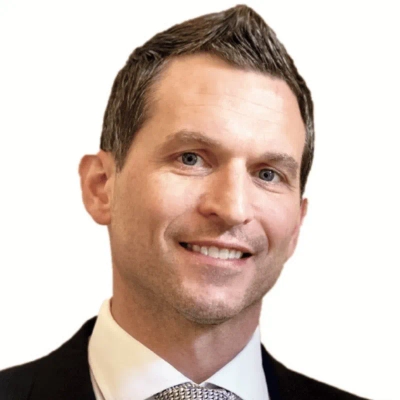19 Counterintuitive Business Decisions Driven by Opportunity Cost Analysis
Business success often hinges on making decisions that appear counterintuitive at first glance, as revealed by seasoned industry experts. These professionals share nineteen real-world scenarios where opportunity cost analysis led to surprising yet effective strategic choices. Their collective experience demonstrates how conventional wisdom can sometimes be challenged to achieve stronger long-term outcomes in competitive markets.
Strategic Customer Investment Saved Our Startup
When our startup was facing significant financial challenges, we made the unconventional decision to approach our largest customer about becoming an investor rather than seeking traditional venture funding. This decision came with substantial opportunity costs, as we had to accept quite restrictive commercial terms that limited some of our market options in the short term. The key insight others might have missed was that survival and continued operation represented greater value than maintaining complete commercial freedom in a business that might not exist otherwise. While many advisors focused on the downside of the restrictive terms, we recognized that this partnership provided not just capital but also a committed customer relationship that would sustain us through the difficult period. This counterintuitive choice ultimately proved successful, as the business not only survived but achieved tremendous growth and meaningful profits within four years.

Cognitive Drag Costs More Than Lost Revenue
Most people think of opportunity cost as a simple fork in the road: you can invest in Project A or Project B, and the cost of choosing A is the potential return from B. But the most profound opportunity costs aren't about choosing between two visible options. They're about the invisible tax that a "good enough" commitment places on your team's attention and creative energy, preventing entirely new, better paths from ever being discovered. It's the cost of what you can't even see yet.
I was once part of a leadership team at a growing company that had a secondary product line. It was profitable, stable, and contributed about 15% of our revenue. The conventional wisdom was to maintain it—why would you ever kill a profitable business? But it was a constant, low-grade distraction. It took up about 20% of our best engineers' time for maintenance, required dedicated customer support, and occupied a significant portion of our mental real estate in every strategy meeting. The counterintuitive decision we made was to sunset it completely, forgoing that guaranteed revenue with no immediate replacement.
The key insight that others missed was that the true cost wasn't the headcount or the server budget; it was the cognitive drag. It prevented us from thinking boldly. I remember one of our most talented engineers, who spent his days patching bugs for that legacy product. After we shut it down, he was initially adrift. But within a month, he had built a prototype for a new tool that solved a core problem for our primary customers in a way we'd never considered. That prototype became our most successful new feature in years. We didn't just free up his time; we freed up his imagination. Sometimes, the most valuable thing you can build is empty space.
Rejecting Custom Work Creates Scalable Solutions
Early on, I walked away from a big contract that would've paid well. The catch? It required heavy customization that would've pulled the entire team off building scalable infrastructure. That's the move nobody talks about, saying no to money so you can say yes to what actually scales.
Here's the trade-off: custom work feels productive because it pays immediately. But every hour spent on one-off solutions is an hour not spent making your core platform faster, more reliable, and capable of serving thousands instead of one. You're essentially trading growth for short-term cash.
The payoff shows up in real results. When organizations use automated reminders, whether it's appointment confirmations, service windows, or event updates, no-shows typically drop 20-30%. Medical practices see fewer missed appointments. Field service teams reduce wasted trips. Schools get better turnout at events. That's the kind of impact you can't deliver if you're stuck building custom features for individual clients.
The framework is straightforward: look at what each decision costs you in focus, speed, and reach. If taking on work means delaying improvements that benefit everyone, it's not worth it. Your team's time is your most limited resource. Spend it building things that compound, not things that expire when one contract ends. Sustainable growth beats quick wins. Every time.

Organic Growth Builds Stronger Customer Loyalty
Early on, we had the opportunity to scale quickly through paid marketing, but we chose a different route. The opportunity cost of not investing in paid ads was clear: slower visibility, fewer immediate conversions, and the risk of falling behind.
But, instead of pouring money into ads, we doubled down on organic growth through valuable content, thought leadership, and word-of-mouth from our customers. At the time, it seemed counterintuitive - faster results from paid marketing were tempting. But we believed that building a brand based on trust and value would pay off in the long run.
And it did. The approach led to stronger brand loyalty. Customers who found us through organic channels were more invested in our product and became advocates, referring others to us. This not only saved money but also created a more authentic connection with our user base.
So the broader takeaway is, while fast growth strategies like paid marketing can be tempting, the most sustainable success often comes from focusing on what you can build over time - trust, relationships, and authentic value. Sometimes, taking a slower, steadier path is the key to long-term growth.

Liquidity Trumps Renovation in Fast Markets
We once bought a dated bungalow in a neighborhood where teardowns were becoming common. My instinct was to renovate, but after running numbers, we saw the opportunity cost of construction delays would prevent us from bidding on two bank-owned properties hitting the market. We sold the lot raw to a developer within days, then used that cash to win both foreclosure auctions--flipping them for 60% combined profit in less time than the remodel would've taken. The key insight? In fast-moving markets, liquidity and timing can outperform even the most attractive renovation margins.
Strategic Patience Outperforms Immediate Action
In our house flipping business, we once faced a property needing extensive renovations in a declining neighborhood. The conventional approach would've been to do minimal repairs and flip quickly, but analyzing opportunity costs led us to instead hold the property for 14 months while focusing on higher-ROI projects. During that time, a major commercial development was announced nearby, increasing the property's value by 22% without us spending on renovations. Others missed that sometimes the opportunity cost of immediate action exceeds the benefit of strategic patience--especially in real estate where market timing can outweigh renovation returns.

Depth Beats Breadth in Hospitality Business
When I was managing multiple Airbnb properties near Augusta National, I had a chance to purchase a sixth property at what seemed like a steal--$320K for a home that would rent beautifully during Masters week. Running the numbers, though, I realized the opportunity cost wasn't just the down payment; it was the time I'd spend managing another property when I could be elevating the guest experience at my existing five units. I turned it down and instead invested $60K into high-end upgrades across my current properties--custom Augusta-themed artwork, spa-quality linens, personalized welcome baskets. My nightly rates increased 35%, occupancy jumped to 92%, and guest satisfaction scores put me in the top 1% of hosts in the area. The insight? In hospitality real estate, the opportunity cost of spreading yourself thin often outweighs the appeal of portfolio expansion--sometimes depth beats breadth.

Relationship Investment Outperforms Property Acquisition
A few years back, I faced a choice: keep pursuing a complex rehab deal that would tie up most of my capital for a year, or pivot to wholesaling simpler homes with far less upfront cost. Counterintuitively, I paused the flashy rehab and devoted myself to wholesaling, focusing on building deeper relationships with agents. That year, not only did my profits increase, but I created a steady deal pipeline that elevated my entire business--proving that sometimes, investing in relationships instead of renovations brings bigger, more sustainable returns.

Preserving Craftsmanship Creates Premium Value
We had a chance to acquire three undervalued properties in Kitsap County simultaneously, which would've been our biggest deal yet, but I realized the opportunity cost wasn't just financial--it was the toll on my crew's morale and craftsmanship. From my 25 years in construction, I've learned that rushing skilled tradespeople across multiple sites destroys the quality and pride that built our reputation. I turned down two of the properties and focused our entire team on one exceptional renovation, which became our showcase project and attracted higher-end clients willing to pay premium prices. The insight? In the home services business, the hidden opportunity cost of overextending your team is the erosion of craftsmanship, and protecting that artisan mindset creates more long-term value than volume ever could.

Cash Agility Beats Due Diligence
Here in Detroit, I passed on buying a seemingly perfect flip property because the due diligence period would have locked up our capital during a sudden market surge. Instead, I used those funds to make three all-cash offers on distressed homes within 48 hours - homes we renovated minimally and resold within 30 days for 40% collective profit. The insight many miss? In volatile markets, the opportunity cost of due diligence isn't just time; it's the lost agility to capitalize on micro-trends only locals can spot.

Focus on Depth Strengthens Healthcare Outcomes
When evaluating service expansion, we chose not to open a second clinic despite strong demand projections. At first glance, it seemed like turning away growth, but the true cost lay in diluting provider attention and patient continuity. By keeping operations centered in one location, we redirected resources into telemedicine and extended hours for existing members. That decision doubled patient engagement metrics within a year and strengthened satisfaction scores far more than adding another site could have. The overlooked insight was that in healthcare, capacity is not defined by square footage but by access and trust. Opportunity cost often hides in the distraction of expansion. Preserving focus on depth rather than breadth protected both care quality and long-term sustainability.

Right Focus Matters More Than Visibility
We once decided to pause a major link-building campaign for a client that ranked decently but had a low conversion rate. At first glance, that move seemed like lost momentum. The opportunity cost of keeping the campaign running, however, was far greater than the temporary ranking plateau. Instead of chasing more backlinks, we redirected the same budget into overhauling on-page experience and revising content to better match buyer intent. The trade-off looked risky because traditional SEO metrics—domain authority and backlink volume—stalled for two months. Yet organic leads increased by nearly 40 percent after the optimization. The overlooked insight was that opportunity cost isn't about what you stop doing; it's about what you free yourself to do better. In digital marketing, the cost of maintaining the wrong focus often outweighs the value of staying visible for the wrong reasons.

Let Clients Experience the Alternative
A seller once told me they were going to sell their home themselves to save the commission. Instead of fighting for the listing, I encouraged them to try it, but to track every hour they spent on calls, showings, and paperwork. They called me back in ten days, exhausted and overwhelmed, realizing the opportunity cost of their own time--missed family dinners and stressful evenings--was far greater than my fee. The insight is that sometimes the quickest way to demonstrate your value is to let a client experience the alternative, proving your service isn't a cost, but an investment in getting their life back.

Short Term Discomfort Builds Long Term Advantage
In my first real estate purchase, I deliberately chose a deteriorating duplex in a challenged neighborhood rather than a turnkey property in a stable area. While the numbers looked worse on paper, I recognized that the opportunity cost wasn't just financial--it was experiential. By immersing myself in a complete renovation (washing dishes in the bathtub while our kitchen was demolished), I gained hands-on skills that became my competitive advantage in identifying value where others saw problems. That decision literally shaped our entire business model. The insight others missed? Sometimes the greatest long-term returns come from embracing short-term discomfort that builds your expertise, not your immediate profit margin.

Fair Deals Generate Valuable Future Referrals
I once had a client with a performing first lien mortgage note who was desperate to sell quickly due to medical expenses. Instead of buying it at a deep discount as most would, I recognized the greater opportunity cost was my reputation and future referrals. I offered a fair market value and arranged a partial purchase--buying just 60 months of payments while letting them retain the back-end balloon payment. This counterintuitive decision to leave money on the table actually generated three additional high-value referrals worth five times what I would've made from an aggressive discount. The insight others missed was that in the private note business, the opportunity cost of short-term profit maximization often exceeds the value of building trust-based relationships that fuel sustainable growth.

Community Reputation Outvalues Single Property Profit
We had a homeowner in Myrtle Beach facing foreclosure on a beautiful waterfront property that needed about $40,000 in flood damage repairs. Every other investor wanted to lowball her because of the repair costs, but I calculated that our opportunity cost wasn't just the repair money--it was the relationship with her and her extended family who owned several other properties in the area. Instead of offering our typical 70% of after-repair value, I offered 85% and took on the flood remediation myself, even though it cut our profit margin significantly. That decision led to her referring us to her brother, sister, and two cousins over the next 18 months, generating over $180,000 in additional revenue. The insight others missed was that in a tight-knit coastal community like ours, the opportunity cost of damaging your reputation with one family can be exponentially higher than the short-term profit you might gain.
People and Momentum Trump Paper Profits
A few years back, I had the option to heavily renovate a modest Reno property or sell it quickly to free up funds. Instead of sinking months of time and capital into flipping it, we sold it as-is and redirected that money to help three local families in probate situations. It ended up being the best financial and reputational move--our community-focused approach turned those families into lifelong advocates, proving that sometimes the highest-return decision comes from valuing people and momentum over projects that only look profitable on paper.

Eliminate Uncertainty to Ensure Long Term Success
Understanding opportunity costs led to a counterintuitive but successful business decision in our operation by forcing us to abandon a seemingly profitable short-term venture to guarantee the long-term integrity of our core mission. The single biggest operational challenge we faced was an acute shortage of high-value OEM Cummins Turbocharger cores, the old diesel engine units necessary for core charges. Conventional wisdom dictated that we should aggressively purchase any available core at high prices to maintain a full inventory of remanufactured parts, which would generate immediate, high-margin revenue.
The counterintuitive decision was to stop accepting almost all core returns and transition our entire business model to exclusively sell Brand new Cummins turbos with expert fitment support. No core charges. We willingly sacrificed the short-term high-margin revenue from remanufactured units, realizing that the opportunity cost of maintaining the remanufacturing process was too high. That process consumed specialized labor, warehouse space, and, most critically, introduced massive quality variability and warranty risk due to unpredictable core quality.
The key insight that others might have missed was that the true cost of the core program was not the purchase price; it was the financial liability tied to operational uncertainty. By eliminating the entire remanufacturing line, we freed up capital and high-value labor to focus exclusively on guaranteeing the quality and immediate fulfillment of the new assets. This decision immediately reduced our 12-month warranty claims and solidified our reputation as Texas heavy duty specialists who deal only in verifiable certainty. The success was measured by the long-term increase in customer loyalty and the complete elimination of a massive, hidden operational risk.

Boring Predictability Beats Volatile Upside
One time I walked away from a huge trending gadget category that everyone was chasing. The quotes looked great at first, but the lead times were unstable and the factories kept shifting cost inputs weekly. The opportunity cost was hidden in how much attention and cash flow that chaos would drain. So I switched to a super boring SKU with 1000 USD MOQ and free inspections through SourcingXpro in Shenzhen. It didn't look sexy, but it printed predictable profit and scaled smooth. The insight most people miss is that the thing you don't choose has a cost too. Anyway boring compounding wins more than volatile upside most of the time.





